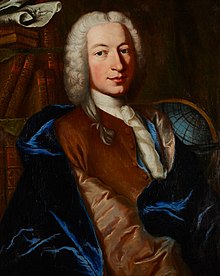Jean-Philippe Loys de Cheseaux

Jean-Philippe Loys de Chéseaux (1718–1751) was an astronomer from Lausanne in Switzerland. In 1746 he presented a list of nebulae, eight of which were his own new discoveries, to the Académie Française des Sciences. The list was noted privately by Le Gentil in 1759, but only made public in 1892 by Guillaume Bigourdan. Chéseaux was among the first to state, in its modern form, what would later be known as Olbers' paradox (that, if the universe is infinite, the night sky should be bright).
De Chéseaux discovered two comets: [1]
- C/1743 X1 — with Dirk Klinkenberg
- C/1746 P1
De Chéseaux also did some little-known research into Biblical chronology, attempting to date the crucifixion of Jesus of Nazareth by analysing astronomical observations in the Book of Daniel. This work was published posthumously in Mémoires posthumes de M. de Chéseaux (1754).
Footnotes
- ^ Archived 2008-07-16 at the Wayback Machine
External links
